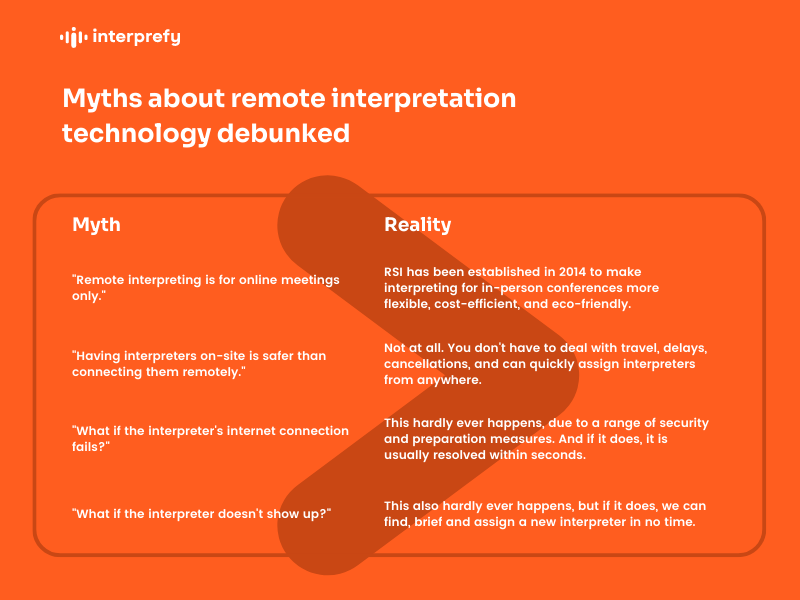Remember the times when suggesting working from home was seen as an absurdity? “There’s no way you can be productive at home”, and other worries long presented a barrier to what today is a driver for productivity. As with any innovation, similarly, the rise of Remote Simultaneous Interpretation has left many with a few basic questions and concerns.
Even though the technology has seen great success and adoption at major conferences ranging from governmental summits to large-scale productions with over 100 simultaneous interpreters since 2014, some first-time users may still be wary to give it a try. And it’s understandable, though, organizing an event is stressful enough, embracing new approaches, especially technologies, can seem daunting or even risky.
In this article, we'll address some of the most recurrent concerns first-time users may have. We’ll shed some light so that they too can enjoy all the RSI benefits, including higher resilience and cost reductions to their fullest.

Myth 1: “Remote interpreting is only for online meetings”
No, quite the opposite. Long before online conferencing became a norm, remote interpretation technology was in fact created to remove logistic hassles at on-site events. Things like having to deal with bulky equipment, clearing enough floor space for sound booths, finding the right interpreters, and arranging their travel and accommodation were some of the major pain points, RSI technology helped to solve.
The “remote” in RSI simply means that interpreters can work from anywhere in the world. That includes the event venue, an interpretation hub, or from the comfort of their homes.
- Remote interpreting for on-site events: back to the future
- Remote simultaneous interpretation: 3 on-site and hybrid scenarios
Myth 2: “Having interpreters on-site is safer than connecting them remotely"
Is it really? Let’s look at some worries about using remote interpreters:
2.1 “What if the internet fails?”
There are many benefits to choosing a cloud-based simultaneous interpretation approach over on-site setups. Some are more obvious, like the ones above, and some are a bit less. Securing interpretation deliverability is one of the great hidden benefits.
Network connection issues: an anomaly quickly resolved
Interprefy has supported over 50,000 events with remote interpreting and network connection issues are extremely rare.
We reported no issues with interpreter's internet connection in 98.9% of all Interprefied events in 2022. Out of the very rare issues reported, most were solved within seconds and did not result in any downtime, while the others resulted in downtime of a few seconds only.
-Dora Murgu, Head of Training and Engagement at Interprefy
This is because there are several ways in which Interprefy secures the deliverability of the interpretation:
1. We choose ethernet over Wi-Fi.
As part of our interpretation training and pre-call soundcheck, we always instruct and control interpreters to have their computers connected with an ethernet cable. A cable connection to the Internet is a must requirement to become an Interprefy Approved interpreter.
2. We always assign interpreters in pairs.
All conference interpreters joining the Interprefy platform work in pairs, regardless of whether they are at the venue or remote. In the instance of a connection issue, the booth partner can take over instantly, to ensure there is no downtime in interpretation. Also, because the two interpreters working on the same language combination can be connected from different locations, if one interpreter experiences connection issues, the other interpreter can instantly take over.
3. We offer a professional interpreter soft console.
If an interpreter working on the Interprefy soft console experiences connection issues, they can activate a "restart all lines (RAL)" function that will restart the connection within 2 seconds or less.
4. We have dedicated remote support technicians on every project.
In every Interprefied event, there is a remote support technician monitoring all interpretation channels who will help interpreters troubleshoot any problems they may experience during the event.
5. We have an emergency protocol.
All interpreters are trained to follow an emergency protocol in case of connection issues, and can temporarily proceed to interpret through the Interprefy mobile app, utilizing their mobile internet connection.
6. We work on a redundant server network.
Our platform is hosted in the cloud, with software installed on a network of multiple redundant servers deployed around the world. Such a distributed cloud set-up with an extensive global network of servers has a huge advantage in comparison to a local installation, as it increases reliability and provides higher quality audio and video transmission as well as the lowest transmission latency.
Additional resources:
2.2. “What if the interpreter doesn't show up?”
In a traditional interpretation in-person set-up, event organisers would expect interpreters to be at the venue at least one hour prior to the start of the event, but what if their flight is delayed, or they’re stuck in traffic? Another interpreter expert in the same language combination and topic would have to be found and travel to the venue within one hour of the event's start time.
In remote interpreting set-ups, interpreters need to connect 40 minutes in advance to do the test call and ensure the sound and connection quality again. If they don't show up, we have a worldwide pool of interpreting talent to look for a replacement who can jump in without needing to travel anywhere.
Additional resources:
- Interprefy-approved interpreter journey
- How does Interprefy source and vet professional interpreters?
2.3 “What if the attendees can't access the remote interpretation?”
One of the beauties of RSI is that it can be used to deliver interpretation to several different set-ups and devices. Interprefy, for instance, can make the interpretation available on mobile phones, on third-party platforms like Zoom, MS Teams or Webex, or via traditional radio / IR receivers at your venue.
RSI provides the flexibility to choose from a multitude of options that best fit your needs. It even allows you to combine the devices you choose to listen to interpreting. So, for example, if more people turn up at an event and there are not enough radio receivers, they can always listen to interpretation using their mobile phones.
Additional resources
- Interprefy Knowledge Base with user guides
- Driving engagement at over 60 FIA events with remote interpreting
Conclusion
As with any new technology, first-time users of remote interpreting might worry that things might not work as well as with the traditional way of doing things. The key, however, is to find the right remote simultaneous interpretation partner, who can deliver the technology but also hands-on expertise to make the whole experience a superb one.
Ready to start enjoying the benefits of RSI?  or download the guide below.
or download the guide below.


-min.png?width=1040&height=800&name=Blog%20Header%20(41)-min.png)


 More download links
More download links



